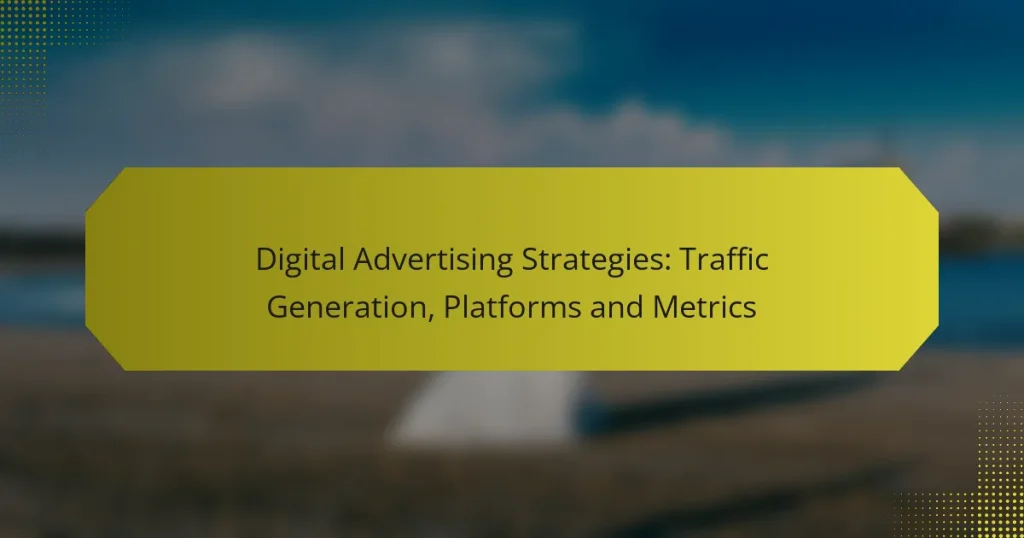Digital advertising strategies are essential for driving traffic and achieving business objectives, utilizing a blend of content marketing, social media, search engine marketing, and more. Selecting the right platforms, such as Google Ads or Facebook Ads, is crucial for reaching your target audience effectively. Additionally, monitoring key metrics like click-through rates and conversion rates is vital for assessing campaign performance and refining your approach.

What are effective digital advertising strategies for traffic generation?
Effective digital advertising strategies for traffic generation include a mix of content marketing, social media advertising, search engine marketing, email marketing, and influencer partnerships. Each strategy has unique strengths and can be tailored to meet specific business goals and target audiences.
Content marketing
Content marketing focuses on creating valuable, relevant content to attract and engage a target audience. This can include blog posts, videos, infographics, and podcasts that provide useful information or entertainment. Consistent, high-quality content can improve organic search rankings and drive traffic over time.
To maximize effectiveness, identify your audience’s interests and pain points. Use SEO best practices to optimize content for search engines, and promote it through social media and email channels. Regularly update and repurpose content to keep it fresh and relevant.
Social media advertising
Social media advertising involves paying for ads on platforms like Facebook, Instagram, Twitter, and LinkedIn to reach specific demographics. These ads can be targeted based on user interests, behaviors, and location, making them highly effective for traffic generation.
Consider using eye-catching visuals and clear calls to action in your ads. A/B testing different ad formats and targeting options can help determine what resonates best with your audience. Monitor engagement metrics to refine your strategy and improve ROI.
Search engine marketing
Search engine marketing (SEM) includes paid advertising on search engines like Google and Bing to increase visibility in search results. This typically involves pay-per-click (PPC) campaigns where advertisers bid on keywords relevant to their business.
To succeed in SEM, conduct thorough keyword research to identify terms your target audience is searching for. Create compelling ad copy and landing pages that align with user intent. Regularly review campaign performance and adjust bids and keywords based on results.
Email marketing
Email marketing is a direct way to reach potential customers by sending targeted messages to their inboxes. This strategy can be effective for driving traffic by promoting content, special offers, or events directly to subscribers.
Build a segmented email list to tailor your messages to different audience groups. Use engaging subject lines and clear calls to action to encourage clicks. Monitor open and click-through rates to optimize future campaigns and improve engagement.
Influencer partnerships
Influencer partnerships involve collaborating with individuals who have a significant following on social media or other platforms to promote your brand. This can help you reach new audiences and drive traffic through trusted recommendations.
Choose influencers whose values align with your brand and who have an engaged audience. Develop clear partnership agreements that outline expectations and deliverables. Track referral traffic and conversions to assess the effectiveness of the collaboration.

Which platforms are best for digital advertising?
The best platforms for digital advertising depend on your target audience and campaign goals. Popular choices include Google Ads, Facebook Ads, Instagram Ads, LinkedIn Ads, and Twitter Ads, each offering unique features and advantages.
Google Ads
Google Ads is a powerful platform for reaching potential customers through search results and display networks. It operates on a pay-per-click model, allowing advertisers to bid on keywords relevant to their products or services.
To maximize effectiveness, focus on keyword research and ad quality. Utilize ad extensions to enhance visibility and provide additional information. Regularly monitor performance metrics to optimize campaigns and adjust bids accordingly.
Facebook Ads
Facebook Ads enables targeted advertising based on user demographics, interests, and behaviors. This platform is ideal for businesses looking to engage with a diverse audience through visually appealing content.
Consider using a mix of ad formats, such as carousel ads and video ads, to capture attention. A/B testing different creatives and targeting options can help identify the most effective strategies. Keep an eye on engagement metrics to refine your approach.
Instagram Ads
Instagram Ads leverage visually-driven content to connect with users, making it suitable for brands with strong visual identities. Ads can appear in users’ feeds, stories, and explore sections, enhancing discoverability.
Utilize high-quality images and videos to create compelling ads. Collaborating with influencers can also amplify reach and credibility. Monitor engagement rates to assess the impact of your campaigns and adjust content as needed.
LinkedIn Ads
LinkedIn Ads are tailored for B2B marketing, allowing businesses to target professionals based on industry, job title, and company size. This platform is effective for lead generation and brand awareness among decision-makers.
Consider using Sponsored Content or InMail for direct engagement. Crafting professional and informative content is key to resonating with the audience. Track conversion metrics to evaluate the success of your campaigns and refine targeting strategies.
Twitter Ads
Twitter Ads provide a platform for real-time engagement and brand visibility. Advertisers can promote tweets, accounts, or trends to reach a broad audience quickly.
Utilize concise messaging and eye-catching visuals to capture attention. Engaging with trending topics can enhance visibility. Regularly analyze tweet performance and audience interactions to optimize future campaigns.

What metrics should be tracked in digital advertising?
Tracking the right metrics in digital advertising is crucial for evaluating campaign performance and optimizing strategies. Key metrics include click-through rate, conversion rate, return on ad spend, cost per acquisition, and impressions, each providing insights into different aspects of your advertising efforts.
Click-through rate (CTR)
Click-through rate (CTR) measures the percentage of users who click on an ad after seeing it. A higher CTR indicates that your ad is engaging and relevant to your target audience. Generally, a CTR of 2-5% is considered average, but this can vary by industry.
To improve CTR, focus on creating compelling ad copy and visuals that resonate with your audience. A/B testing different headlines and calls to action can help identify what works best.
Conversion rate
The conversion rate is the percentage of users who take a desired action after clicking on your ad, such as making a purchase or signing up for a newsletter. A good conversion rate typically ranges from 1-5%, depending on the industry and type of campaign.
To enhance conversion rates, ensure that your landing pages are optimized for user experience and aligned with the ad’s messaging. Clear calls to action and minimal distractions can significantly boost conversions.
Return on ad spend (ROAS)
Return on ad spend (ROAS) measures the revenue generated for every dollar spent on advertising. A ROAS of 4:1, meaning $4 earned for every $1 spent, is often seen as a healthy benchmark. However, acceptable ROAS can vary based on business goals and industry standards.
To maximize ROAS, continually analyze ad performance and adjust targeting, bidding strategies, and creative elements. Investing in high-performing ads can lead to better overall returns.
Cost per acquisition (CPA)
Cost per acquisition (CPA) indicates how much it costs to acquire a customer through your advertising efforts. Keeping CPA low is essential for maintaining profitability. A typical CPA can range from $10 to $100, depending on the product and market.
To lower CPA, refine your targeting to reach more qualified leads and optimize your ad spend. Regularly reviewing and adjusting your campaigns can help identify areas for cost savings.
Impressions
Impressions refer to the total number of times your ad is displayed, regardless of whether it was clicked. This metric helps gauge the reach of your advertising efforts. High impressions can indicate strong visibility, but they do not guarantee engagement or conversions.
To effectively use impressions, combine this metric with CTR and conversion data to assess overall campaign effectiveness. A high number of impressions with a low CTR may signal that your ad needs to be more appealing or relevant to your audience.

How to choose the right digital advertising strategy?
Choosing the right digital advertising strategy involves understanding your goals, audience, and the competitive landscape. A well-defined strategy aligns your advertising efforts with measurable outcomes, ensuring efficient use of resources.
Identify target audience
Identifying your target audience is crucial for effective digital advertising. Start by creating detailed buyer personas that include demographics, interests, and online behaviors. This helps tailor your messaging and select the right platforms for engagement.
Consider using tools like Google Analytics or social media insights to gather data on your existing audience. This information can guide your targeting decisions, ensuring your ads reach those most likely to convert.
Set clear objectives
Setting clear objectives is essential for measuring the success of your digital advertising strategy. Define what you want to achieve, whether it’s increasing brand awareness, generating leads, or driving sales. Use the SMART criteria—Specific, Measurable, Achievable, Relevant, Time-bound—to formulate your goals.
For example, instead of a vague goal like “increase sales,” aim for “increase online sales by 20% in the next quarter.” This clarity allows you to track progress and adjust your tactics as needed.
Analyze competitor strategies
Analyzing competitor strategies provides valuable insights into what works in your industry. Research their advertising channels, messaging, and engagement tactics to identify gaps and opportunities in your own approach. Tools like SEMrush or Ahrefs can help you assess their online presence and ad performance.
Look for trends in their campaigns, such as popular keywords or successful ad formats. Understanding these elements can inform your strategy and help you differentiate your brand in a crowded market.

What are the prerequisites for successful digital advertising?
Successful digital advertising requires a clear understanding of your target audience, a well-defined budget, and effective metrics to measure performance. These elements help ensure that your campaigns are both efficient and impactful.
Budget allocation
Budget allocation is crucial for maximizing the effectiveness of your digital advertising efforts. It involves determining how much money to invest in various channels, such as social media, search engines, and display ads, based on their potential return on investment (ROI).
Consider allocating your budget across different platforms based on their performance and audience reach. For instance, if social media ads yield higher engagement rates, you might allocate a larger portion of your budget there. A common approach is to start with a 60-30-10 split, where 60% goes to high-performing channels, 30% to emerging platforms, and 10% to experimental campaigns.
Regularly review and adjust your budget based on campaign performance. Use metrics like cost per click (CPC) and conversion rates to guide your decisions. Avoid overspending on underperforming ads and be ready to reallocate funds to more successful strategies.


